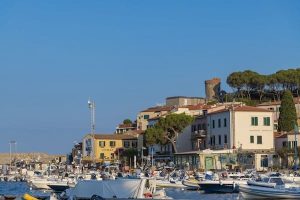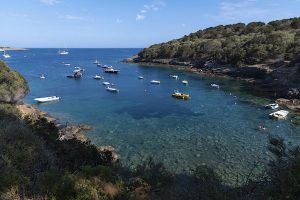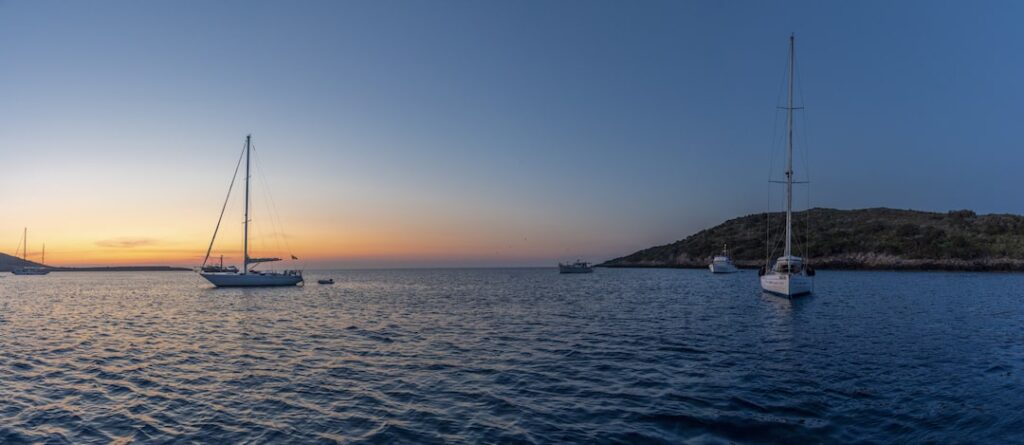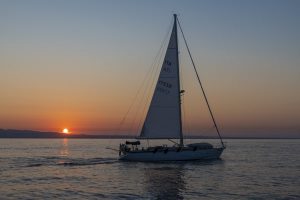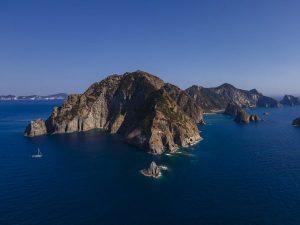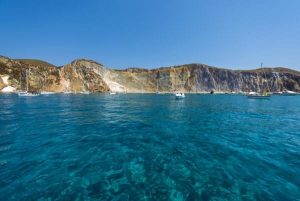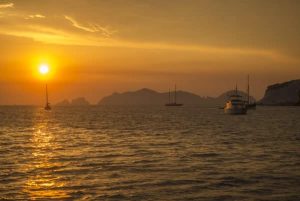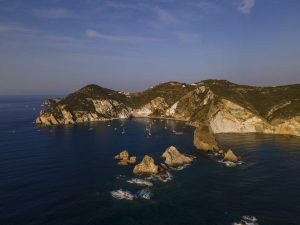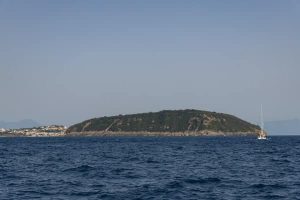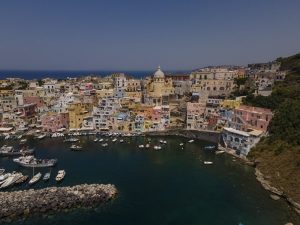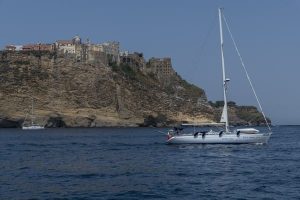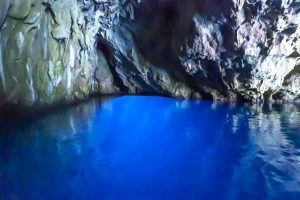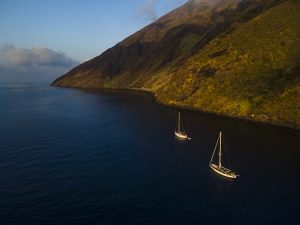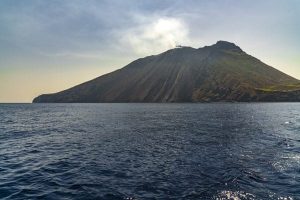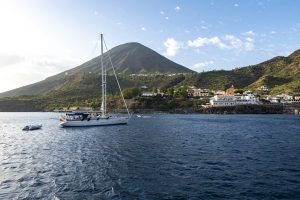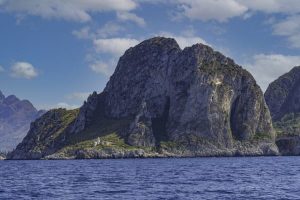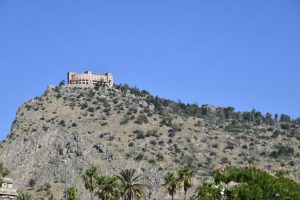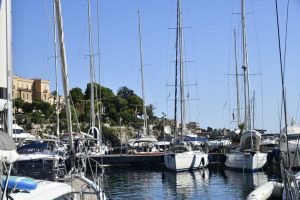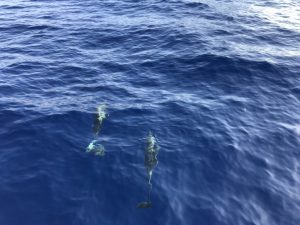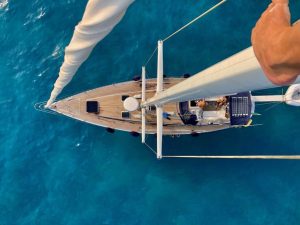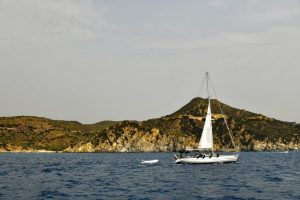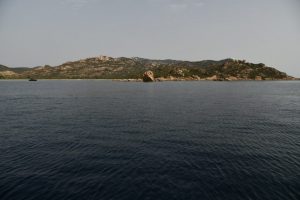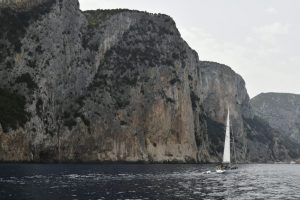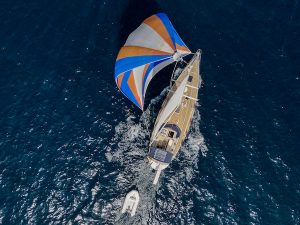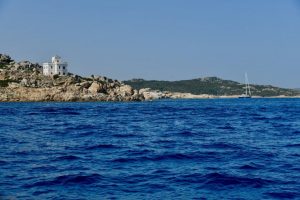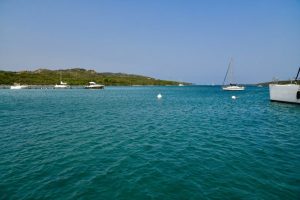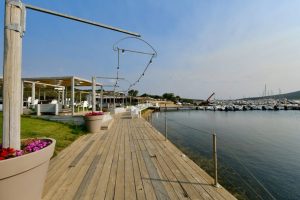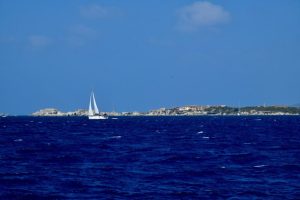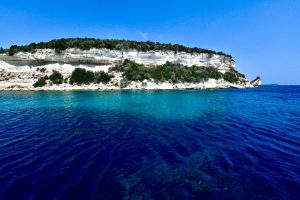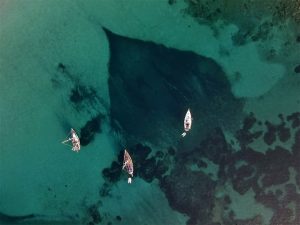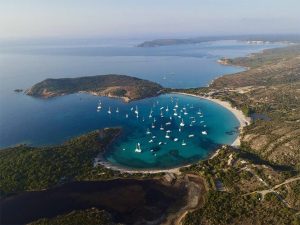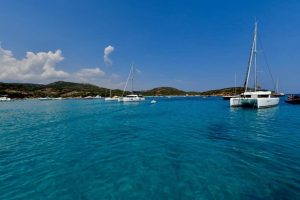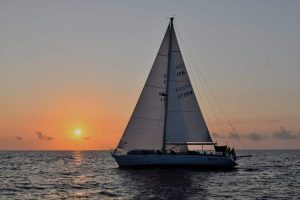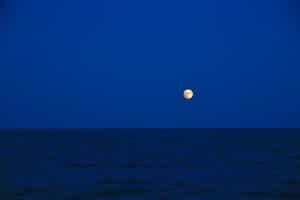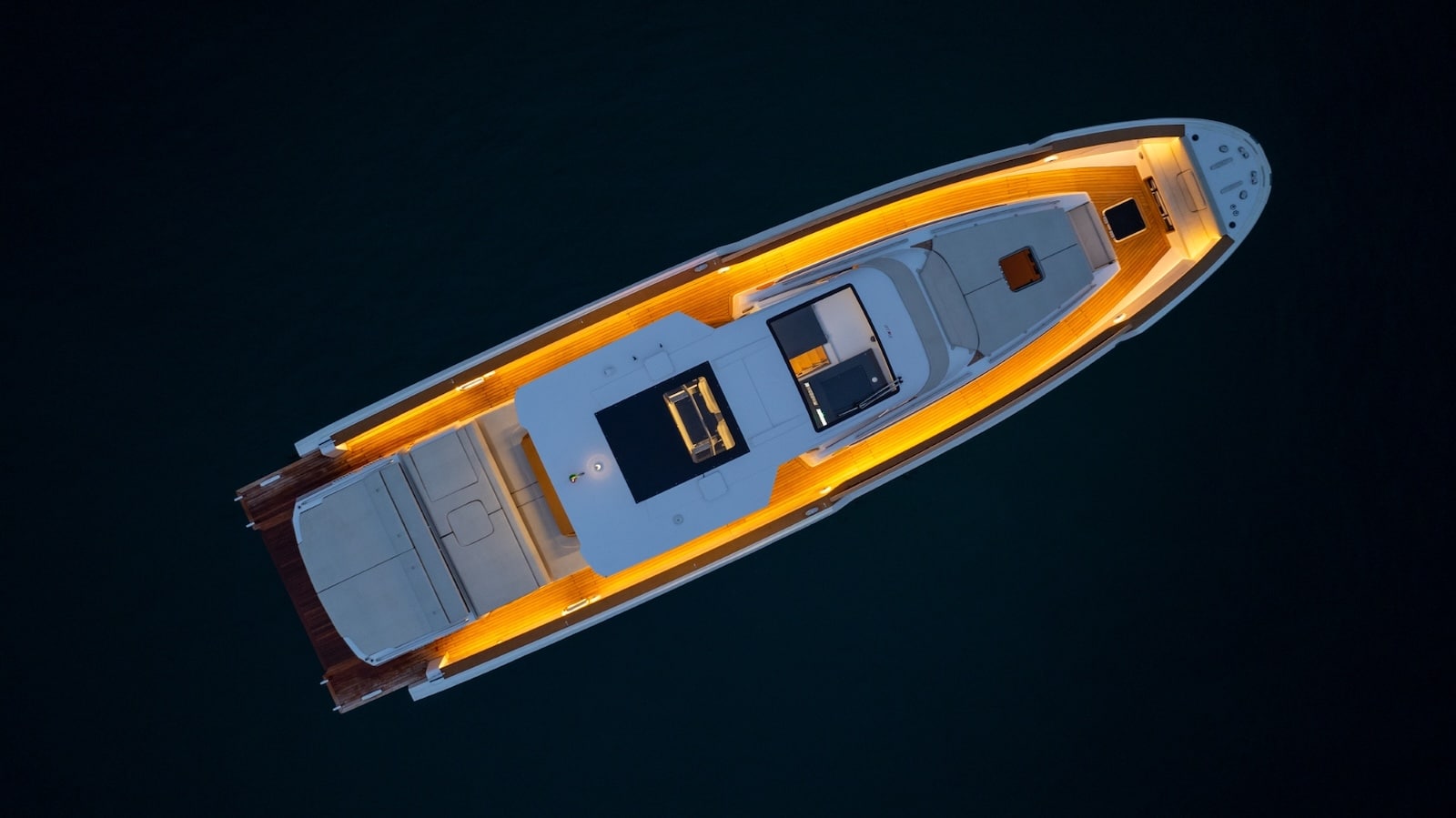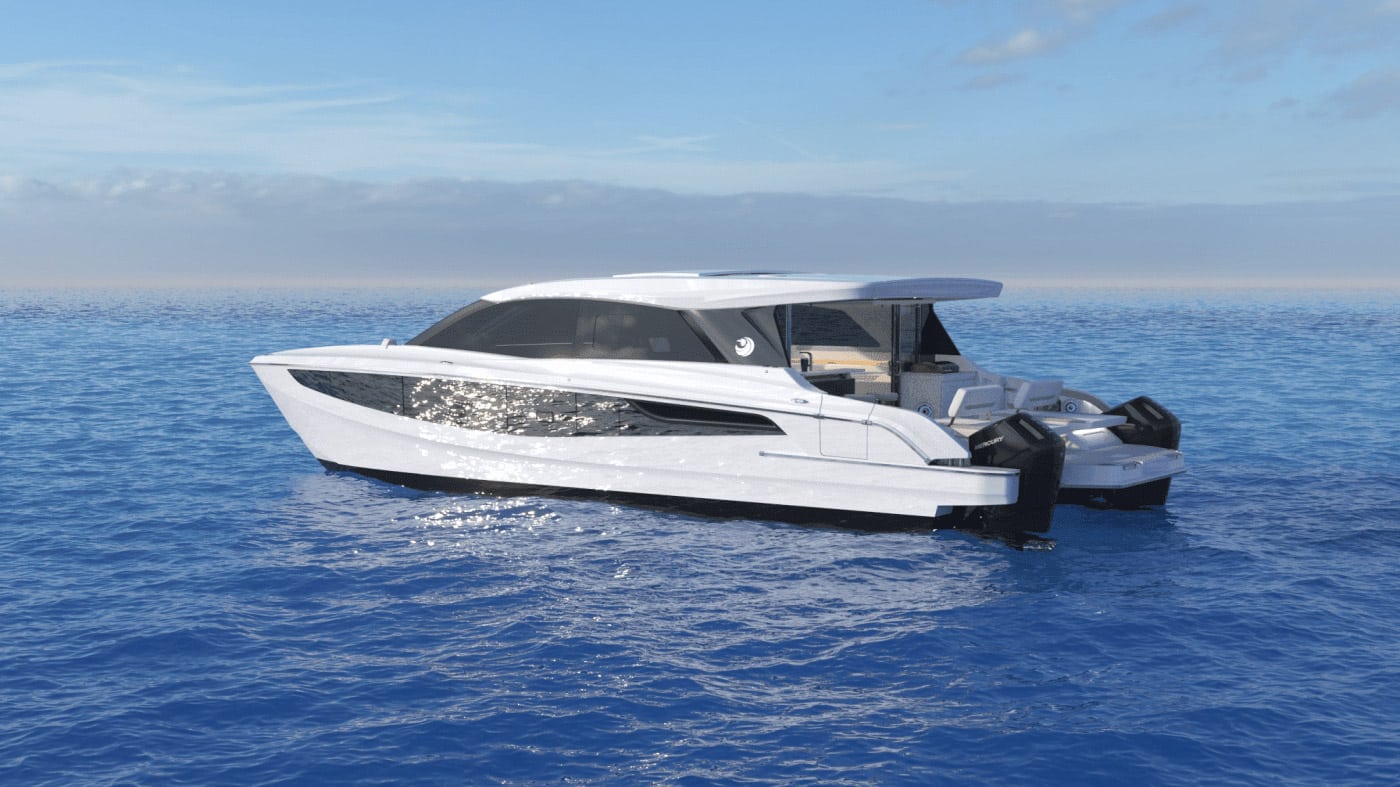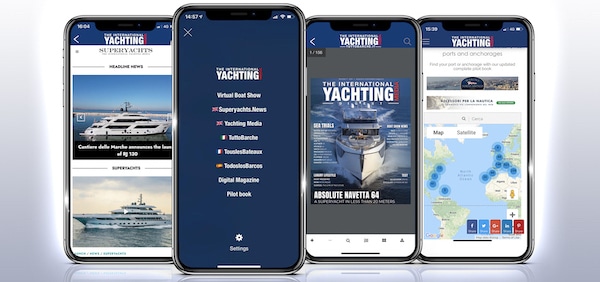1,000 miles in the Tyrrhenian Sea: logbook
Day 1 – Varazze – Portovenere – 17/7/2021
Marina di Varazze: no-stress departure with unexciting sailing towards Portovenere, in a variable 8-knot north wind and crosswave. 60 miles in 9 hours. Saturday night at anchor in Portovenere, with the anchor dropped in a 10-meter muddy and sandy seabed. Plenty of space available even if the bay is crowded. In the background, the colours of the town lit up by the setting sun, the temperature rises to cool the evening.
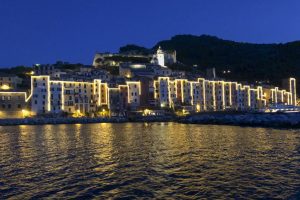
7 a.m: we have a coffee and set sail for Capraia. Portovenere is still asleep while we sail along the islands of Palmaria and Tino, heading 175° – 68 miles. The weak wind doesn’t give us much fun, but we enjoy the beautiful sunny morning and the presence of a pod of dolphins off the inaccessible Gorgona. Aeolus wakes up in the afternoon and we “fly” to Capraia. Here is Capraia Porto, dominated by the Forte di San Giorgio, overhanging the sea, built by the Genoese and the Banco di San Giorgio in the 15th century to repel Saracen assaults. We spend the night in the crystal-clear waters of Cala del Ceppo to the south-east of the island, protected from the mistral by cliffs covered in fragrant Mediterranean scrub.
Day 3 – Capraia – Elba Island / Marina di Campo
After a sleep in Cala del Ceppo, interrupted by more or less violent gusts of mistral, we take a morning bath among jumps of tuna. We set sail for the Elba Island, which is just 18 miles away. As we sail along the west and south sides of the island, after Punta di Fetovaia, we come to the Pisan tower of the Marina, which dominates the small beach of Cala Galanzana fringed with pine trees near Marina di Campo. We decide to drop anchor on the seabed of posidonia and rock in this more intimate and uncrowded bay and spend the night there.
Day 4 – Marina di Campo
Phagocyted by the holiday atmosphere of Marina di Campo, we saunter along the harbour quay full of fishing boats armed with nets and lines for catching blue fish. The shady alleyways of the old village lure us into a moment of relaxation. The stepped ascent of Via Bellavista takes us along a path to the sandy beach of Galenzana, which can only be reached by sea and from where we can see our boats at anchor.
Day 5 – Marina di Campo – Giannutri
7 a.m: we have a coffee and set sail for the island of Giannutri via Giglio Island. The sea is as smooth as oil, and generous too, since it has provided us with tonight’s dinner. We anchor in Cala dello Spalmatoio on a 21-metre sand and posidonia seabed. The cliffs are covered with marine cysts, juniper, rosemary and mastic, the scent of the Mediterranean scrub and maritime pines, the chirping of the cicadas and the clear blue sea stun the senses. Access to the island requires a ticket to be paid to the Tuscan Archipealogo National Park either directly at the bar in the piazzetta or online, at least the day before (only €4 per person). The ticket only allows you to walk along the dirt road from Cala dello Spalmatoio to Cala Maestra; you are not allowed to leave the path unless accompanied by a guide. The ruins of the Villa Romana can only be visited in the morning and accompanied by a Park Guide (8€).
Day 6 – Giannutri – Santa Marinella
One of the good reasons for a healthy passion for sailing and living long periods aboard one’s own boat is to spend the days following the natural rhythms of the passing of time. Today, for example, the sunrise on the island of Giannutri made us feel at peace with the world. Then, we headed ashore to refuel and rest in Santa Marinella, anchored on 4 metres of sand, sheltered from the mistral winds by the end of the marina.
Day 7 – Santa Marinella – Palmarola Island
Departure before dawn: heading 146° to the island of Palmarola, 79 miles, 10 knots of crosswind. The monotony of the Lazio coast is interrupted by the Circeo promontory, which stands out imposingly. Defined by Folco Quilici as “the most beautiful island in the Mediterranean”, Palmarola is just four miles from the island of Ponza. Its high, jagged coastline, punctured by caves and rocky spires, is reminiscent of Hawaiian scenery. We visit Cala Tramontana, known as “The Cathedral”, but anchor in front of Scoglio Spermaturo, a sharp cleft in the cliff on a turquoise seabed.
Days 8 and 9 – Palmarola Island- Ponza
Lazy-day awakening after a long crossing. The volcanic cliffs battered by the wind and waves create a breath-taking backdrop. We sail towards the south of the island; Cala Mezzogiorno with its rocks and white rocky amphitheatre is home to dozens of boats at anchor, but the sea starts to rise, the strong Sirocco wind is coming. We decide to take refuge in Chiaia di Luna, one of Ponza’s most beautiful bays. Closed since 2001 and forbidden to the public because of the risk of landslides, the beach even offers a tunnel, dug by the Romans and finished with walls in opus reticolatum, as a direct passage to Ponza Porto.
Day 10 – Ponza Island – tourism
A day dedicated to finding photo/video images between Ponza and Palmarola. We sail between the two islands in a south-easterly wind and stop at the most famous inlets of Ponza, first of all Chaia di Luna with its cliffs and anphitheatre, then Cala Lucia Rosa with its rocks and stacks and Cala Feola with its pools. At Palmarola, we explore Cala di Porto, a small beach overlooked by some cave dwellings dug out of the tufa rock and a few more recent structures. The Pontine Islands are a group of volcanic islands formed by several eruptive cones, as you can easily tell by looking at the high, tormented cliffs. Monte Guardia (283 metres above sea level), Ponza’s highest point, dominates the island’s characteristic profile.
Day 11 – Ponza Island – Procida
Here we are in Procida,in the Gulf of Naples, the next European Capital of Culture 2022 and for some time now the site of interesting encounters in art, cinema and literature. It is part of the group of Partenopean islands, together with Ischia and Vivara, which are of volcanic origin, and Capri, which is of sedimentary origin. Covering almost 4 square kilometres, the island has as many as 4 craters and very steep and jagged coastlines, especially to the south and east. The settlement of Terra Murata stands out on the north-eastern bastion. We spend the night in Chiaiolella, one of the most colourful and lively marinas in the Mediterranean.
Day 12 – Procida – Naples – Capri
Breakfast at the bar in the Chiaiolella marina with sfogliatelle and lingue di bue filled with Procidan lemon cream. A 12-knot crosswind allows us to sail across Capri in total relaxation, until the island’s imposing rocky cliffs force us to continue under power. The town of Capri, with its famous “Piazzetta”, is right above us, in the central part of the island, 142 metres above sea level. Anchored and night under the cliffs and stacks of Marina Piccola, the sea around us is dotted with illuminated superyachts at anchor.
Days 13 – 14 – Capri – Acciaroli – Palinuro – Stromboli
7 o’clock, the silent Quick anchor windlass retrieves the chain, and we leave quietly so as not to wake up the neighbours at anchor. The stacks are illuminated by the still low sun, and we take advantage of the opportunity to fly the drone in search of the most spectacular scenes for our docufilm on the “1000-mile cruise in the Tyrrhenian Sea”. We set course for Acciaroli, 42 miles away, filled up with diesel and set off for Palinuro in a couple of hours. We arrive just in time to anchor in a huge deserted bay, launch the Selva tender with the new EPropulsion electric motor and off we go to explore the famous “Blue Grotto”. The sun is setting, but we are able to enjoy the incredible phenomenon of refraction whereby the bottom of the cave is a luminescent blue. We wake up very early, have a quick look at the enchanting Buondormire bay and are off again. Heading for Stromboli, 74 miles, no wind, flat sea, but suddenly the reel whistles. We stop the engine: 20 minutes of struggle and the skipjack Katsuwonus pelamis of about 15/18 kg, practically the maximum for the species, is on board, arms aching, but we already look forward to the feasts…. for several days!
Day 15 – Stromboli – Basiluzzo – Panarea
Awake at dawn, the low sun paints the Stromboli volcano in the most typical Mediterranean shades. The Daydreamer snoozes at anchor in a bay not far from the village. We are only a few miles away from Ginostra and the famous “Sciara del Fuoco”, the colliery where the volcano discharges its eruptions; just yesterday there was a fairly major one. A few miles, just 11, and we sail along the west side of the Basiluzzo rock; we pass by under sail for the filming of the docufilm and throw again in the crowded pool between Lisca Bianca and Lisca Nera, two rocks that create a shallow bottom. From there to Panarea is an instant, we look for anchorage, discover that hundreds of buoys have been placed in two separate fields…. a madness of red balls with few boats: 100€ for one night, we prefer to move away to drop anchor south of the town. Just to get off we have our Selva 320 VIB tender equipped with the new Epropulsion electric motor. The evening in Panarea is one of elegance and good living.
Day 16 – Panarea – Lipari – Vulcano
We wake up again at dawn, these volcanic islands deserve some extra effort to get the best images. These are African days and the light during the day is not optimal from a photographic point of view. The green island of Panarea runs along our sides, the few miles that separate us from Lipari will be covered quickly, a strong wind upwind pushes us that is a pleasure, finally! We drop the anchor on a clear seabed opposite the abandoned structures of the pumice quarries. I remember that, 30 years ago, it was possible to roll in the pumice sand along steep walls down to the sea. Not any more, shame. The same 30 years have passed since I spent some time in Lipari, it doesn’t seem to have changed much, it’s still a nice, tidy, colourful town: a granita and a Sicilian cannolo from the Subba pastry shop is a must (and maybe a dinner at Filippino’s restaurant). Half an hour and we are already in Vulcano, in the Porto di Levante bay. The seabed is shallow, let’s say within 20 metres, so I recommend anchoring early to find a place in the roadstead. The village of Vulcano is even more colourful than Lipari, with small shops and bars lining the narrow streets, all dominated by the splendid polychrome volcano.

The many boats anchored in the bay of Vulcano- Porto di Levante are still asleep. After a pleasant evening ashore and a quite night at anchor, we set sail to discover the western coast of Lipari: steep, rugged, wild and uninhabited=wonderful. The large bay of Punta Levante in Lipari offers shelter to a few yachts and superyachts, in a truly primeval setting. The wind gets stronger and we are in Salina, with the two majestic volcanoes in the background. We drop anchor at Salina Porto, a pretty, well-kept, quaint village, to collect the Raymarine Axiom 9 Plus, which has arrived at Marina di Salina for testing on board. The wind picks up from the north-east and we move into the sheltered bay of the village of Rinella on the south coast of Salina, right in the middle between the two volcanoes.
Day 18 – Rinella – Vulcano
Today, the weather is crazy and unpredictable, an uncomfortable situation when at anchor: jumps in wind direction and speed, insidious waves from different directions; in short, a good reason to review the weather notions absorbed over the years. After a fleeting visit to the village of Rinella, unexpectedly pleasant and characteristic, we head for the bay of Pollera, to the west of the island of Salina. It is a bay created by the collapse of an ancient volcanic crater, and the village lies on the top of the cliff: stairs carved into the rock reach the sea. The sea is too rough to stay at anchor and tonight’s forecast calls for strong winds from various directions, so we decide to shelter in the Bay of Punta Capo Secco at Vulcano, which seems ideal for spending the night. It turns out to be a magical place, with the sheer cliff, the stacks, the cave in the next bay and the sunset in your face. We end the evening with one of the most spectacular views of the starry sky we have ever experienced.
Day 19 – Vulcano – Filicudi
The hot summer night has passed and we are back at sea: today we are going to discover the island of Filicudi, which rises from the deepest depths, 20 miles west of Salina. The northern side is uninhabited and steep, battered and volcanic. Filicudi Porto is located in a bay protected by Capo Graziano, a famous point of interest for underwater archaeology due to the presence of numerous ancient wrecks. Our destination is “la Canna”, a 60-metre high stack of basaltic rock emerging from a very clear sea: it is time to shoot more footage for our docufilm, and the Daydreamer sails as far as the obelisk. We go to anchor in one of the most beautiful places on the Aeolian Islands, Pecorini, a small village clinging to the rocks with the typical white houses that characterise these islands. In the evening, at aperitif time, the place comes alive with tourists, residents and yachtsmen, drinking, chatting and eating delicious local food prepared by the local women in an atmosphere reminiscent of tropical islands.
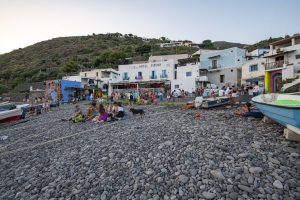
We wake at dawn,
we have a 63-mile crossing to make from Filicudi to Palermo, and the weather does not look good. In fact, the Mistral comes in early and starts blowing hard from the early morning hours. Our speed is good, but the wave, which is already quite strong on the lee side, is very annoying. The wind shifts to the north as we approach the Sicilian coast, allowing us to make a single tack to our destination, the beautiful Villa Igea marina in Palermo, where we will spend the night and get some rest. Dinner in cheerful Mondello is a must – we’ve really earned it.
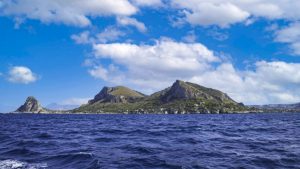
Rest day at the Marina Villa Igiea in Palermo, a strategic location at the centre of the southern Tyrrhenian navigation routes and starting point for a visit to the city of Palermo, not far away. Pleasant evening and dinner on the boat based on fish and typical Sicilian pastries with dear local friends.
Day 22 – Palermo – San Vito Lo Capo
After having replenished our galley, water and fuel oil, we leave Marina Villa Igiea and, pushed by a north-easterly wind, head for San Vito lo Capo, a small town on a sandy beach, an old fishing village before the recent tourist development and famous for its couscous festival. We spend the night here at anchor, waiting to set sail for Sardinia.
Day 23 – San Vito lo Capo – Villasimius
We leave the large bay of San Vito Lo Capo at 9 a.m. We have carefully planned our route and times according to the weather conditions we will find. As soon as we have rounded the cape with its slender white lighthouse, we set a course of 284, with 163 miles of open sea ahead of us. The wind from the south is around 18-25 knots, we manage to keep a good heading and a not bad speed between 6.5 and 9 knots, let’s hope it stays that way! After 3 hours we are still upwind, in the same conditions: it doesn’t seem true… even if the sea is rising and long, swollen waves are passing under our hull. Wind and sea are getting stronger, we decide to reduce a bit of canvas to sail more comfortably, the speed is high, around 8 or 9 knots, a show! As predicted, the wind and sea magically drop, we continue more slowly and in complete safety: life line, inflatable and umbilical jackets, binoculars, frontal light, Lizard shoes on our feet and a light jacket. In the middle of the night, we switch on the engine to charge the batteries and give our speed a little boost. Cloudy, dark night with no moon, colourless sunset and sunrise, a pity to miss the stars. Towards 6 a.m., the expected east wind rises rapidly to over 20 knots: we arrive in Villasimius almost flying through the strait between Capo Carbonara and Isola dei Cavoli: 25 hours exactly, not bad!
Days 24 and 25 – Villasimius
Days dedicated entirely to writing articles, testing products and taking videos and photos. Since we are at anchor about 1 mile from the port, we take the opportunity to test the battery of the Epropulsion electric outboard, installed on our Selva 320 Vib. A problem with the anchor light at the mast head, instead, gives us the excuse to test the Ewincher electric handle, which lifts me effortlessly to the top. The clear, bright waters, the shallow depths and the white sand allow us to take video footage of the Ultra Marine anchor and test its potential. We also test the water resistance of the Spin Lizard boot by immersing it up to the edge and noting its total waterproofness, as well as the non-slip capacity of the Crew Lizard shoe.
Day 26 – Villasimius – Cala Murtas
Today, we take it easy, we set sail from Villasiumius to shoot with the drone for our documentary, one flight and the wind rises above the safety limit. What a shame! The island of Cavoli and Capo Carbonara deserved spectacular views from above. Wind in the face, nothing to do with the sail, the mainsail simply stabilizes. We head for Arabatax but, once we’re reached the bay of the Murtas beach, we decide to anchor for the night because the place is really amazing.
Day 27 – Cala Murtas – Cala Coloritza
We wake up in a surreal calm, the sea is oil, a light mist of humidity envelops everything, the light is subdued. We swim ashore to walk along a kilometre-long, completely deserted beach where nature has the upper hand. It’s time to set sail, of course we only sail by motor, the little wind is upwind. We sail along a coastline that is sometimes very high with cliffs, sometimes with very white beaches as far as Arbatax, where the cape with a lighthouse hides the port structures that spoil the landscape. From here on, the coast rises ever higher to form sheer cliffs of polychrome limestone. Capo Monte Santo is the gateway to the famous Gulf of Orosei, where tomorrow we will visit Sardinia’s most famous beaches and bays, such as Cala Luna with its caves. We decide to spend the quiet night at anchor before Cala, under an eerie rock overhang. We visit one of the caves and take the tender to discover its blue refractions.
Day 28 – Cala Coloritza – Isola Ruja
7.00 a.m.: drone shots of the incredible sheer cliffs that characterize the whole coastline as far as Cala di Luna. We set sail, letting cliffs and bays flow by like in a film: Cala degli Innamorati, Cala Piscina di Venere, Cala Biriola, Cala Sisine and, finally, Cala di Luna. We arrive before 10am, few people, few boats, a dream. At 10.30 a.m. 6 tourist boats arrive all together, unloading hordes of people on the beach, all wanting to get a place in the sun. We leave. We cut across the Gulf of Orosei, skipping Cala Gonone with its little port, preferring to reach Isola Ruja with its gigantic dune beach, where we will spend the night sheltered from the swell from the east. A sunset aperitif at the Il Moletto oyster bar on the beach.
Day 29 – Isola Ruja- Capo Coda Cavallo
The warm light of the early morning illuminates Isola Ruja and its vermilion rocks in contrast with the bright turquoise of the shallow waters, the wind is absent, we take home some footage with the drone. The temperature rises, weak but with a direction favourable to us; today we will sail for just over 20 miles. Armed with the gennaker, we manage to sail at over 6 knots in complete relaxation. We arrive at Capo Coda Cavallo, with the islands of Mortorio and Tavolara in the background. The large, beautiful bay is full of boats at anchor: we were not the only ones to identify this place as an ideal place to spend the night with an easterly wave. We find our spot. Sunset.
Day 30 – Capo Coda Cavallo – Porto Pozzo
A strong mistral wind is forecast from early afternoon, so we set sail at dawn for Porto Pozzo, a well-protected marina, where we will also try to solve a problem with the Daydreamer’s hydraulics, with the help of trusty Ugo Soldi of Continental Marine, of course. A pleasant evening around a table with a good glass and Sardinian sweets.
Days 31 and 32 – Porto Pozzo
The mistral forces us to make a long stop in this rather rustic, almost Caribbean, but very well organised and managed marina. We take the opportunity to continue writing editorials and testing equipment such as the Raymarine Lighthouse chart and the Quick Rider 3 windlass.
Day 33 – Porto Pozzo – Gulf of Sant’Manza.
Although the mistral has diminished, it continues to be strong, with gusts of over 30 knots. We decide to set sail anyway, two days in port are already too many. We wait for the gusts to diminish a little and leave the mooring, we’re finally sailing again. A handkerchief of mainsail and a little more of genoa and we make 7 knots. As we leave the gulf, the sea is still smooth and protected from the coast, but as soon as we enter the Bocche di Bonifacio, things get more serious. The distant mistral swells up to 3 metre waves, to which are added others of at least one metre, which don’t bother us too much on the crosswind; we exceed eight and a half knots and shortly afterwards we are already sheltered by the island of Cavallo, half an hour and we round the cape of Santa Manza, pure fun.
Day 34 – Corsica – Sant’Manza – Gulf of Rondinara
We spend the day on turquoise waters, between the bay of Santa Manza and that of Rondinara, characteristic for its almost perfect semi-circular shape, bordered by a very white beach. As we enter, we must take into account the shallow water aligned with the northern tip and anchor in front of the beach. Of course, in season the bay is quite crowded, but this does not prevent us from enjoying the view.
Day 35 – Rondinara – Pinarellu
We leave Rondinara early in the morning for Porto Vecchio. As we enter the fjord, we see the village perched on the hill in the background. We drop the anchor and visit the old town: founded by the Genoese in 1539, it is a citadel with houses and alleyways in porphyry, surrounded by ramparts, now full of small shops and characteristic places. We take to the sea again to reach the large bay of Pinarellu and enjoy a swim at sunset. Evening at the little bar on the beach with local cold cuts and cheeses and… Corsican music.
Days 36 and 37 – Pinarellu – Varazze
At 7.30 am, we set sail for a northbound navigation that will take us to our final destination, Varazze. The wind is moderate, crosswind, we manage to sail at around 6/7 knots and without wave, what more could we ask for? After 72 miles, finally with a little bow wave, we arrive in the bay of Marine de Pietracorbara, just for a refreshing swim and an aperitif on the beach and off we go again. The weather conditions are changing, we decide that the best option is to cross immediately. A wonderful night of full moon spent sailing at between 7 and 8 knots. Then the wind lets up and the last 35 miles are sailed under a cloudy, threatening sky that brings us back to the reality of the return journey.
The journey continues…
1,000 miles in the Tyrrhenian Sea
1,000 miles in the Tyrrhenian Sea, the technical cruise of the Daydreamer, the lab-boat of The International Yachting Media, is back again this year. This 6th edition will see the crew of the Daydreamer engaged in numerous tests of various on-board tools, tested with the clinical eye of expert navigators. Anchors, cartography, valves, nautical accessories and much more, will all be installed during the cruise and subjected to intensive use and non-maintenance on purpose, just to verify their resistance even in prohibitive conditions.

A complete technical cruise
Mandatory stops include the Tuscan Archipelago, the Phlegrean islands, ten enchanting islands in total on which the crew of The International Yachting Media will cast their eyes. Then at least a hundred or more miles of sailing to touch the Aeolian archipelago with its volcanic outcrops resting on the blue sea; crossing westwards to the Egadi Islands and then northwards towards the southern coast of Sardinia. The lighthouses that light up like huge white candles, many anchorages to discover, and then the ancient port of Bonifacio. Corsica: buttery croissants and gentle bonjours will be a wonderful memory when the Daydreamer lands back at her usual mooring port on the edge of the fragrant Ligurian land.
There will be many surprises in store for us during the 1000 miles in the Tyrrhenian Sea, which will be released in a work in progress with which we will keep our readers updated, as in open logbook. Because it is the real experience at sea that counts the most, together with the immensity of the sails that push us far away to discover that curiosity that is reserved with pride only for the surfaces of the abyss. We have just one objective: to tell you the best of our shared passion for the sea. Stay tuned!






